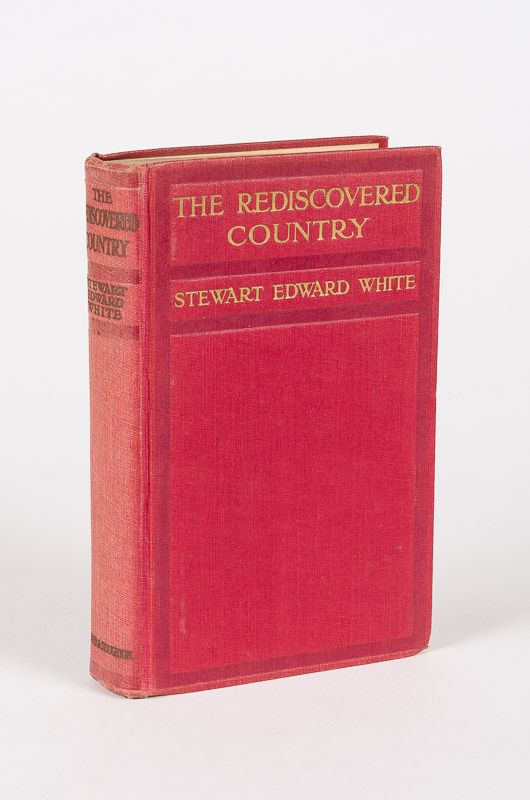White, The Rediscovered Country.
The Rediscovered Country. Illustrated from Photographs.
London, New York, Toronto, Hodder and Stoughton, no year. 14 cm x 22 cm. Frontispiece, VIII, 358 pages. 100 illustrations. Fold-out map of region at rear. Hardcover [publisher’s original red cloth] with gilt lettering on spine and front board. The fold-out-map with tear. Otherwise in very good condition with only minor signs of external wear. Interior bright and clean and sharp-cornered.
Account of Big Game hunting expedition across German and British controlled East Africa.
The publication is interesting for illuminating Western attitudes to Africa and Africans during the early years of the 20th century.
Stewart Edward White (12 March 1873 – September 18, 1946) was an American writer, novelist, and spiritualist. He was a brother of noted mural painter Gilbert White.
From about 1900 until about 1922 he wrote fiction and non-fiction about adventure and travel, with an emphasis on natural history and outdoor living. Starting in 1922 he and his wife Elizabeth “Betty” Grant White wrote numerous books they say were received through channelling with spirits. They also wrote of their travels around the state of California.
White was born in Grand Rapids, Michigan, the son of Mary E. (Daniell) and Thomas Stewart White, a lumberman. He attended Grand Rapids High School, and earned degrees from University of Michigan (B.A., 1895; M.A., 1903). White’s books were popular at a time when America was losing its vanishing wilderness. He was a keen observer of the beauties of nature and human nature, yet could render them in a plain-spoken style. Based on his own experience, whether writing camping journals or Westerns, he included pithy and fun details about cabin-building, canoeing, logging, gold-hunting, and guns and fishing and hunting. He also interviewed people who had been involved in the fur trade, the California Gold Rush and other pioneers which provided him with details that give his novels verisimilitude. He salted in humor and sympathy for colorful characters such as canny Indian guides and “greenhorn” campers who carried too much gear. White also illustrated some of his books with his own photographs, while some of his other books were illustrated by artists, such as the American Western painter Fernand Lungren for “The Mountains” and “Camp and Trail”. Theodore Roosevelt wrote that White was “the best man with both pistol and rifle who ever shot” at Roosevelt’s rifle range at Sagamore Hill.[2]
The Long Rifle (1930), Folded Hills (1932), Ranchero (1933), and Stampede (1942) constitute The Saga of Andy Burnett, which follows a young Pennsylvania farm boy who escapes his overbearing step father by running away to the West with grandmother’s blessing and “The Boone Gun”, the original Kentucky rifle carried by Daniel Boone. He encounters mountain man Joe Crane, who becomes his mentor in the ways of survival in the wild. The remainder of the saga follows Andy as he moves west, ultimately settling in California, which is the setting of the last three books. The series incorporates actual events and characters from the time period in the narrative. The four stories were published as a posthumous volume, The Saga of Andy Burnett, in 1947, and were adapted into several episodes of The Wonderful World of Disney during 1957 and 1958, starring Jerome Courtland as Andy Burnett, and Jeff York (Mike Fink) as his friend and mentor Joe Crane. This series was in many ways a follow-up to Disney’s much more successful Davy Crockett. In 1927 the Boy Scouts of America made White an Honorary Scout, a new category of Scout created that same year. This distinction was given to “American citizens whose achievements in outdoor activity, exploration and worthwhile adventure are of such an exceptional character as to capture the imagination of boys…”. White died in Hillsborough, California. (Wikipedia)
- Keywords: Africa – Rare · Africana Collection of Rare Books · American Author(s) · Animals · Big Game · Big Game Hunting · Books with vintage Maps · East Africa · East Africa Map · Fishing – Rare · Hunt · Hunting · Hunting – Rare · Native, Rituals and Customs · Natives · Nature · Settler · Settlers · Spiritualism · Travel · Travel Africa – Rare · Travel and Adventure · Travel Guide · Travel Journal · Travel Photography · Travel Writing · Travel-Guide · Travellers · Travelling Authors · Wildlife
- Language: English
- Inventory Number: 120135AB
EUR 145,--
© 2025 Inanna Rare Books Ltd. | Powered by HESCOM-Software












